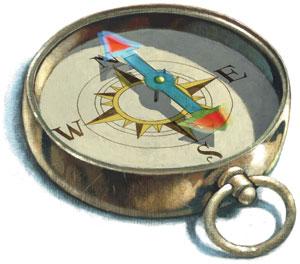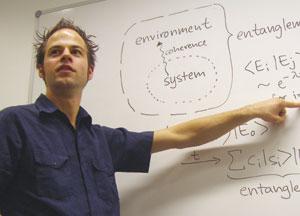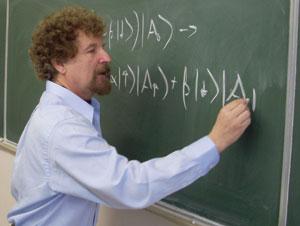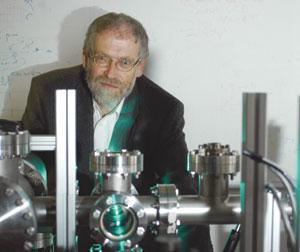How does our classical world emerge from the counterintuitive principles of quantum theory? Can we even be sure that the world doesn't 'go quantum' when no one is watching? Philip Ball talks to the theorists and experimentalists trying to find out.
 D. PARKINS
D. PARKINSKeith Schwab builds bridges. By most people's standards, they are very small bridges indeed: around 8 thousandths of a millimetre long and 200 millionths of a millimetre wide, visible only under a microscope. But to Schwab's eye, these objects are huge. That's because he is hoping to see them behave according to the rules of quantum mechanics — rules that allow for bizarre, counterintuitive behaviour such as being in two places at once. Quantum mechanics is generally thought to govern objects such as individual atoms, not lumps of matter like these bridges, which contain tens of billions of atoms.
It is an ambitious goal. But Schwab, based at Cornell University in Ithaca, New York, is one of several experimentalists seeking to probe one of the great conundrums of modern physics: the quantum–classical transition. Here, the fuzzy quantum world somehow gives way to the solid, definite certainties of the everyday 'classical' world as we go up the scale from atoms to apples. If these experiments manage to confirm current theories of this transition, they could turn long-standing preconceptions about quantum theory on their head.
Early quantum theorists treated the quantum–classical transition almost as a kind of sleight of hand, something that had to be imposed on quantum mechanics to recover the familiar world. Now, however, there are strong signs that the transition can be understood as something that emerges quite naturally and inevitably from quantum theory. If that's so, it implies that 'classicality' is at root simply another quantum phenomenon. “There's good reason to believe that we are just as much part of the quantum world as are the tiny atoms and electrons that sparked quantum theory in the first place,” says quantum theorist Maximilian Schlosshauer of the University of Melbourne in Australia.
Testing the new description of the quantum–classical transition involves experiments on systems ranging from photons to superconductors to microscopic vibrating beams. These efforts pose an extreme challenge to experimentalists, as they involve looking for very small effects on comparatively big things — rather like trying to detect the sag when a fly lands on San Francisco's Golden Gate Bridge. The effects very quickly get so small that many physicists believe it is absurd to try to see them. “One crowd says: 'Of course it will work — quantum mechanics says so',” says Schwab. “The other says: 'There's no way it will work — these guys are nuts'.”
“One crowd says 'of course it will work'. The other says 'these guys are nuts'.”
Keith Schwab
Yet there's now some urgency to the search: understanding the transition is becoming crucial for the emerging field of quantum information technology, which includes quantum computing and ultra-secure data encryption and transmission. Such practical applications may depend on an ability to hold classical behaviour at bay, sustaining the quantumness at big scales.
In part this is a technical challenge, which the experiments on the quantum–classical transition might help to address. But it is also a challenge to our understanding of the basic theory. Some physicists think that how quantum behaviour should be interpreted remains as unclear today as it was when Niels Bohr, Werner Heisenberg, Albert Einstein and others were developing (and arguing over) the theory. “This is an emotional issue,” says quantum technologist Chris Monroe from the University of Maryland in College Park. “Some insist that there is no problem; others insist that there must be an infinity of universes, each with their own classical description of a definite quantum state.” (see refs 1 and 2.) As explorations of the quantum–classical transition become more sophisticated, it may become increasingly feasible to put such ideas to the test, answering questions that until now have remained almost metaphysical.
Where does the weirdness go?
To understand what the quantum–classical transition really means, consider that our familiar, classical world is an 'either/or' kind of place. A compass needle, say, can't point both north and south at the same time. The quantum world, by contrast, is 'both/and': a magnetic atom, say, has no trouble at all pointing both directions at once. The same is true for other properties such as energy, location or speed; generally speaking, they can take on a range of values simultaneously, so that all you can say is that this value has that probability. When that is the case, physicists say that a quantum object is in a 'superposition' of states.
Thus, one of the key questions in understanding the quantum–classical transition is what happens to the superpositions as you go up that atoms-to-apples scale? Exactly when and how does 'both/and' become 'either/or'?
 Maximilian Schlosshauer thinks that even 'classical' things are quantum in their own way.K. SCHLOSSHAUER
Maximilian Schlosshauer thinks that even 'classical' things are quantum in their own way.K. SCHLOSSHAUERPhysicists have proposed many answers to that question over the decades. But the most favoured one involves a phenomenon known as decoherence3, which was identified and elucidated in the 1970s and 1980s. Crudely speaking, decoherence is a sort of leaking away of quantum behaviour when a particle interacts with its surroundings — for example, when an atom or molecule collides with those around it, or when light bounces off it. All we are left with is a partial picture of the system — a picture in which only a well-defined subset of macroscopic properties, such as position, are apparent.
Why those particular properties? In the 1980s, Wojciech Zurek, now at the Los Alamos National Laboratory in New Mexico, offered an answer. In effect, different quantum states have very different resistances to decoherence. So only the resistant states will survive when a system interacts with its environment. These robust states are those that feature in classical physics, such as position and its rate of change, which is associated with momentum. In a sense, these are the 'fittest' states — which is why Zurek and his colleagues call their idea quantum darwinism4,5.
Decoherence also predicts that the quantum–classical transition isn't really a matter of size, but of time. The stronger a quantum object's interactions are with its surroundings, the faster decoherence kicks in. So larger objects, which generally have more ways of interacting, decohere almost instantaneously, transforming their quantum character into classical behaviour just as quickly. For example, if a large molecule could be prepared in a superposition of two positions just 10 ångstroms apart, it would decohere because of collisions with the surrounding air molecules in about 10−17 seconds. Decoherence is unavoidable to some degree. Even in a perfect vacuum, particles will decohere through interactions with photons in the omnipresent cosmic microwave background.
“The same object can behave as a quantum system in one situation, and as a classical system in another.”
Anton Zeilinger
In summary, decoherence offers a way “to understand classicality as emergent from within the quantum formalism”, says Schlosshauer. Indeed, this picture means that the classical world no longer sits in opposition to quantum mechanics, but is demanded by it.
It all sounds good in theory — but is decoherence real? Can we actually see quantum effects leaking away into the environment? Serge Haroche and his colleagues at the Ecole Normale Supérieure in Paris began to put the idea to the test in 1996 by studying bunches of photons held in a type of light trap called an optical cavity6. They passed a rubidium atom through the cavity in a superposition of two states. In one state, the atom interacted with the photons to cause a shift in their electromagnetic oscillations, whereas the other state caused no change. Then, when the experimenters sent a second atom through the trap, it was affected by the state of the photons induced by the first atom. But that effect became weaker as the photon field decohered, so the measurements made on the second atom depended on the time delay since the passage of the first. In this way, Haroche and his colleagues could watch decoherence set in by altering the timings of the two atoms7.
Sliding doors
The decoherence description shows that there is no abrupt boundary, no critical size, at which quantum behaviour switches to classical. And that blurry boundary itself shifts depending on how it is measured. “It is the choice of the measuring apparatus that defines whether a specific object is quantum or classical,” says Anton Zeilinger of the University of Vienna. His team provided an example of this nine years ago, when it demonstrated quantum interference between beams of C60 fullerene molecules8 — hardly as classical as the footballs they resemble, but nonetheless big molecules that can be seen with an electron microscope. Interference — the addition or cancellation of overlapping waves — is in this case a purely quantum effect, and can't be understood if the molecules are viewed as discrete particles. It is possible only if the molecules are in a superposition of states — in several places at once. “If you scan with a scanning tunnelling microscope a surface to which fullerene molecules stick, you see the little soccer balls sitting there as classical objects,” says Zeilinger. “But if you choose our interference experiment set-up, they are quantum mechanically delocalized.” In other words, he says: “The same object can behave as a quantum system in one situation, and as a classical system in another.”
This makes the fullerene experiment an ideal quantitative test of the theory of decoherence. In a subsequent experiment with even bigger C70 molecules, Zeilinger's team saw that the molecules' interference patterns gradually disappeared as the gas through which the molecules passed became more dense. In a denser gas there are more collisions, and thus more coupling to the environment, so the molecules decohere more quickly. The researchers found that the decay of quantum coherence and interference happened at precisely the rate predicted by the theory. They have now seen similar behaviour with even more massive molecules, including fluorinated C60 (C60F48) and modified porphyrin molecules with a plate-like shape (C44H30N4) (ref. 9).
“The important point is that the conditions for an observation of interference effects can be precisely specified and quantified using theoretical decoherence models,” says Schlosshauer. “We no longer have to limit ourselves to the assumption of a poorly defined yet fundamental divide between the quantum and classical realms.”
 Wojciech Zurek proposes that decoherence selects for certain 'robust' states in an almost darwinian manner.E. THOMMES
Wojciech Zurek proposes that decoherence selects for certain 'robust' states in an almost darwinian manner.E. THOMMESIndividual molecules still seem a long way from our classical world. But decoherence has also been watched in genuinely macroscopic objects: hoops of superconducting material. Superconductivity is an inherently quantum-mechanical behaviour, and electrical currents in a ring of superconducting material called a superconducting quantum interference device (SQUID) can be placed in a superposition of states that circulate in opposite directions[10],[11]. These states can then be monitored by looking at the interference between them. In 2003, researchers at Delft University of Technology in the Netherlands showed that a related approach, using pulses of microwaves to excite oscillations in a superposition of superconducting current states, could also be used to investigate decoherence[12]. As in Haroche's experiments, decoherence shows up as a weakening of the correlations between oscillations of the superposition states as the time between pulses lengthens.
Superpositions in superconducting currents may still seem a little remote from the apparent absurdity of finding tangible objects, much bigger than atoms or molecules, in two places at once. But Schwab and his collaborators think that it should be possible to detect such quantum superpositions in 'rough' lumps of matter: their tiny resonating beams, which are examples of nanoelectromechanical systems (NEMSs). These objects are small enough that their vibrations should be governed by quantum mechanics: they should be restricted to specific energy levels, and thus specific frequencies[13]. But the separation between energy levels is very small, so quantum behaviour will be blurred unless the resonators are kept very cold to eliminate thermal noise.
Schwab says that he thinks he is now very close to seeing a NEMS resonator in its lowest-energy (ground) quantum state. At temperatures of around 25 millikelvin, he and his colleagues have managed to restrict the vibrations to only the 25 lowest energy levels of the system, and he says he hopes to 'suck out' all the remaining excited states by active cooling, akin to the laser cooling used to draw heat from small clusters of ultracold atoms.
The Cornell researchers have proposed an experiment to search for superposition states in NEMS resonators[14]. As in other quantum systems, Schwab says, “as soon as you look for the superposition, you destroy it”. So the superposition can only be inferred from its effect on another system to which the resonator is coupled. Schwab's group will look at how interactions between the resonators and a nearby quantum bit or 'qubit' — a quantum device that can exist in two states, like the binary memory elements of a computer — induce decoherence in the qubit. This type of coupling will have a particular signature, says Schwab: coherence will reappear periodically at a rate equal to the vibration period of the beam. “That's the smoking gun,” he says. This would reveal quantum effects in a system containing around ten billion atoms — much more than is feasible with molecular-interference experiments.
“There is no information without representation.”
Wojciech Zurek
Even more ambitious, however, is a proposal by Dirk Bouwmeester of the University of California, Santa Barbara, and his colleagues to create superpositions in the position of macroscopic mirrors moved by the radiation pressure of a single photon in a superposition state[15]. Inevitably, this would involve extremely high-precision measurements: the researchers calculated that for a cube-shaped mirror measuring 10 micrometres in each dimension, with a mass of 5 trillionths of a kilogram and containing about 1014 atoms, they would have to measure positions to within 10−13 metres — close to the width of a proton, but nevertheless potentially feasible with interferometric methods.
Smoke and mirrors
Bouwmeester hopes that it will soon be possible to test an alternative theory of the quantum–classical transition devised by Roger Penrose of the University of Oxford, UK. Penrose suggests that the 'collapse' of a superposition, rather than being a gradual affair resulting from environment-induced decoherence, is a rather abrupt event that is mediated by gravity. That is, it involves the emission of a graviton, the hypothetical fundamental quantum of the gravitational force, in much the same way that the decay of an excited molecule may happen via emission of a photon. He thinks that the cost in gravitational potential energy of keeping objects in a superposition becomes too great as objects get bigger, so that the objects 'go classical' on a definite timescale, which he estimates to be about a second or so for dust particles. Bouwmeester's mirror experiment should, if he can scale it up without losing sensitivity, be able to spot such a switch. “I am sceptical about this idea, but think it is worth testing,” he says.
Understanding quantum states has become much more than an intellectual curiosity, because handling quantum data may hold the key to the future of information technology. By exploiting the extra degrees of freedom that superpositions offer, quantum computing could greatly increase computer power, at least for some computational problems. And encoding data in entangled quantum bits (the polarization states of photons, say) can provide a secure way to send information, as intercepting or reading the data would trigger irreversible quantum collapses that should be detectable. So understanding decoherence, the coupling of quantum systems to their environment and the fundamental nature of quantum measurement becomes crucial to manipulating information along quantum paths. “To build a quantum computer,” says Schlosshauer, “the main challenge remains to shield the computer sufficiently from the environment to minimize decoherence while keeping it sufficiently open to allow its control from the outside. Research on quantum computing has inspired many ways of actively controlling decoherence and even of effectively 'undoing' its effects.”
Too much information
At first glance, quantum computing seemed to be sunk by the fact that superpositions can't be measured without destroying the 'information' they encode. But about 10 years ago researchers found that, as long as the background decoherence level in a quantum computer is small enough, quantum information stored in qubits can be retained by redundant encoding. “Several qubits are used to store just a single effective qubit of information,” says Monroe, “and particular measurement schemes allow full recovery of quantum information in the face of decoherence.”
One of the challenges in engineering these devices is identifying what is causing the decoherence. “The particular way to encode qubits will depend on the details of the decoherence source,” Monroe explains. “Some decoherence sources are much easier to recover from than others.”
 In the quantum world, says Anton Zeilinger, what you see may depend on how the measurements are made.J. GODANY
In the quantum world, says Anton Zeilinger, what you see may depend on how the measurements are made.J. GODANYIf these efforts succeed in scaling up quantum computing from the mere handfuls of qubits demonstrated so far to truly macroscopic systems, the result will be not only a boon for computing itself but a forceful illustration of how quantum effects can survive at scales normally deemed 'classical'. “Some day we will have a roomful of equipment that will have to be considered a single quantum entity in the same way as a single atom is,” says David DiVincenzo, who works on quantum computing at IBM's research labs in Yorktown Heights, New York.
On the other hand, maybe in pushing the envelope of the quantum–classical transition, quantum information technology will uncover some unanticipated, fundamental aspect of it. “If in the process of building a large-scale quantum computer we find that decoherence always sets in at some level of complexity — a universal law that says quantum mechanics only goes so far — then that would be very interesting,” says Monroe.
Zurek, meanwhile, sees a deeper significance in quantum information technology: he says it shows that information lies at the core of quantum theory. “Taking information seriously has profound consequences,” he says. “Perhaps the most important is that there is no information without representation — a physical state of some object is needed to store information.” Concepts such as decoherence and quantum darwinism make sense only because information matters, he says. “They all have to do with how information flows.”
The decoherence description of the quantum–classical transition is not necessarily the end of the matter — it leaves unresolved some more fundamental questions about the interpretation of quantum theory (see page 39). But at present, it seems a fair bet that what we think of as the classical world is really only the quantum world viewed through the lens of decohered states. “The conceptual leap would then be to conclude from this that quantum mechanics is truly universal,” says Schlosshauer, “in the sense that everything, including us, is described by entangled quantum states.”



No comments:
Post a Comment